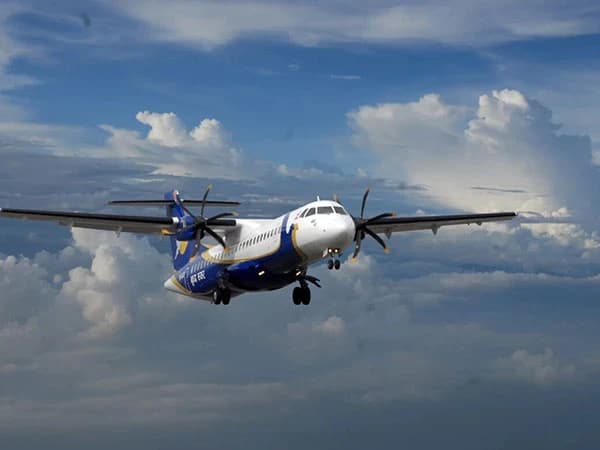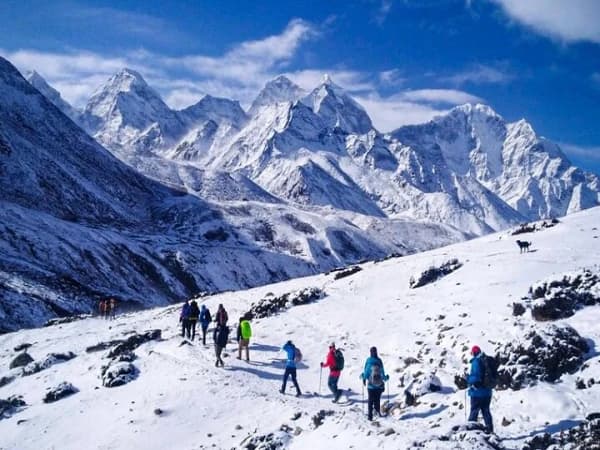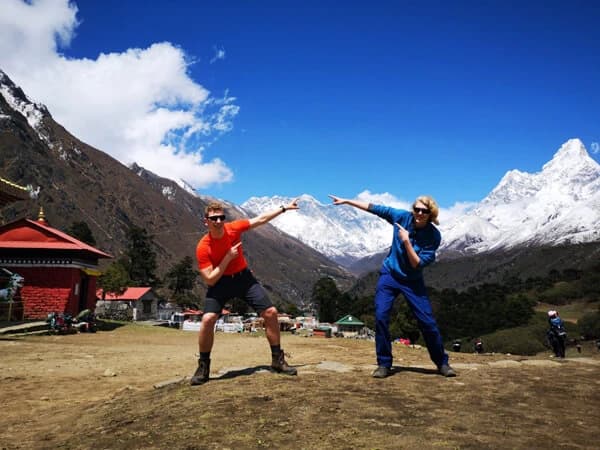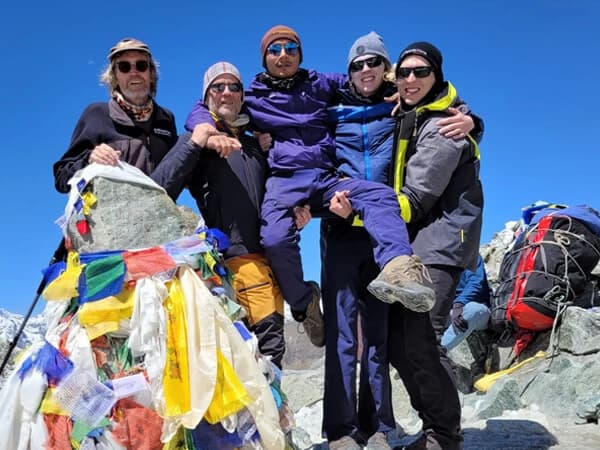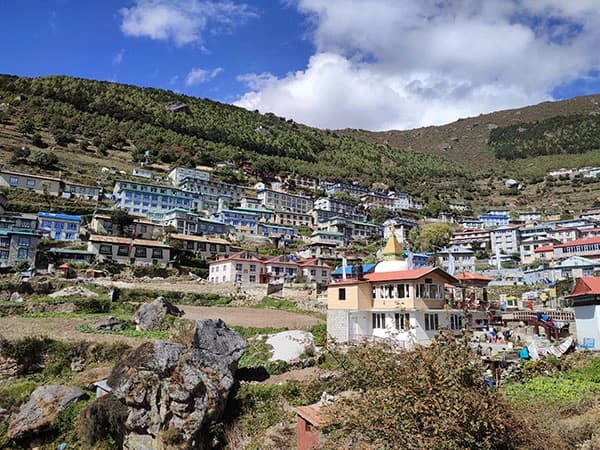The Everest Region, otherwise known as the Khumbu or Solo Khumbu region, is a well-known trekking and climbing area in northeast Nepal. The Everest region is home to Mt Everest (8848 m) - the tallest mountain on earth - along with incredible scenery and conditions, as well as further magnificent mountains, including Lhotse, Nuptse, Makalu, and Ama Dablam, all of which create memorable trekking experiences.
Sagarmatha National Park is a UNESCO World Heritage Site and seeks to conserve and protect the area's biodiversity. While trekking, you may also see wildlife, including the Himalayan Tahr, musk deer, red panda, and golden eagles, along with forests of pine, rhododendron, and juniper. The terrain and altitude of Sagarmatha National Park can make trekking challenging. Some examples of treks include the Everest Base Camp Trek, the Gokyo Lakes Trek, and the Three Passes Trek (one of the toughest in any country).
Culturally, the area is at the center of Sherpa country, which is famous for its hospitality and greatness in mountaineering. Buddhism is thriving culturally and physically (there are monasteries, prayer flags, and festivals - including one that is functional at Tengboche Monastery). You can expect a kaleidoscope of Sherpa, Tibetan, Buddhist, and Nepali cultures, which means a trip that sees you here is an important journey back in time in a natural and cultural sense.
Quick Facts About Everest Region
- Location: Sagarmatha National Park, Solukhumbu District, Northeastern Nepal
- Elevation Range: From ~3,300 m (Namche Bazaar) up to 8,848 m (Mount Everest summit)
- Park Area: 1,148 km², plus a 275 km² buffer zone
- UNESCO Status: World Heritage Site since 1979
- Glaciers: Khumbu Glacier — the highest on Earth (approximately 17 km); Ngozumpa (the longest in Nepal at ~36 km)
- Peaks: Along with Everest, the list goes on with Lhotse (8,516 m), Cho Oyu (8,153 m), Nuptse (7,896 m), Ama Dablam, Pumori, and even more
- Fauna: Snow leopard, red panda, musk deer, Himalayan tahr, Himalayan black bear, over 200 bird species
- Flora Zones: The vegetation changes from pine/hemlock forests, rhododendron and birch woodlands to alpine meadows and barren rock/ice
- Sherpa Culture: The people there are mainly Sherpas that are between 3,000 and 6,000 in number, and they are spread out over about 20 villages (for instance, Namche, Tengboche, and Pangboche).
- Visitor Numbers: Tourist visits increased dramatically—from ~3,600 (1979) to ~49,000 annually.
Why Everest Draws Trekkers From All Over the World?
- Unrivaled Scenic Beauty: The trek offers breathtaking scenery, including forests, meadows, rivers, and mountains, including Ama Dablam and Everest, all of which establish the trek as a visual art form and photographer's dream.
- Cultural Experience: While simply undergoing the physical challenge, the trekkers also learn about the Sherpa people and their rich culture, visit the monasteries, associate with the local people, and learn the Buddhist's ways of spirituality.
- Adventure and Personal Challenge: One of the factors attracting people to come to the Everest Himalayas to trek is the challenge and the happiness of accomplishing the task of reaching the base camp of the world's highest mountain. This is a test of good physical fitness, but does not necessarily require technical climbing skills.
- International Appeal and Social Experience: Everest Base Camp is a place where different nationalities come together and talk, share ideas, and create new adventures that make the social aspect of the trek more interesting.
- Symbol of Human Perseverance and Achievement: Everest represents the idea that one can overcome great difficulties and fulfill one's dreams, and it is the motivation of adventurers all over the world to be their best.
- Economic and Touristic Importance: For Nepal, the trek of Everest is the most important source of income as it attracts hundreds of thousands of tourists every year, and the money goes to the local communities and infrastructure.
- Accessibility Compared to Summit Attempts: Climbing the peak of Everest is the dream of almost all climbers. Simply trekking to the base camp is reachable for many, given proper preparation, which makes it a popular goal for those who want to experience Everest without technical climbing.
- Spiritual Significance: Everest is considered sacred by both Buddhists and Hindus, and thus, it becomes the magnet for those who come for spiritual connection in addition to their adventure.
The Most Popular Treks in the Everest Region
Everest View Mountain Flight - 1 Hour
This one-hour flight from Kathmandu presents a bird's eye view of Mount Everest and the neighboring Himalayan mountains, Lhotse, Makalu, and Cho Oyu.
Besides that, with the comfortable window seats, the passengers get expert commentary, and they can take pictures of the snowy peaks, glaciers, and valleys from above. It is suitable for all ages and fitness levels and perfect for those who want to enjoy the beauty of Everest without trekking. Flights leave daily early in the morning for the best visibility.
Everest Base Camp Helicopter Tour with Landing - 1 Day
The helicopter journey from Kathmandu to Everest Base Camp with a landing makes this one-day trip full of fun. It also leads to a better understanding of Everest, its neighboring peaks, and the bountiful nature of Khumbu.
The tour normally involves a pit stop for breakfast at the Everest View Hotel, which now turns into a totally different experience since it offers a singular viewpoint without the physical strain of trekking. This is the best choice for people who have very little time or are not able to do the trek but still wish to enjoy the close-up of Everest.
Everest View Trekking - 9 Days
The Everest View Trekking 9 Day Trek is a moderately difficult trek that gives you the opportunity to have stunning views of Everest and other Himalayan giants without going to base camp. You will trek through Sherpa villages, rhododendron forests, and Buddhist monasteries; so you will get to experience Sherpa culture while having a terrific experience in nature. This trek is perfect for people with time constraints or moderate levels of fitness and provides an excellent overall Himalayan experience featuring outstanding views of the mountains and people from the area.
Everest Base Camp Trekking - 14 Days
This classic 14-day trek brings you to Everest Base Camp, which is the entrance to the world's highest peak. The trek includes suspension bridges, visits to Sherpa villages such as Namche Bazaar, and trekking across Sagarmatha National Park. Trekkers will find incredibly beautiful sweeping mountain views, glaciers, and another iconic photo of Everest Base Camp! This trek is an ideal balance of challenge, culture, and nature, and has made it popular with trekkers from around the world.
Gokyo Cho La Pass Everest Base Camp Trek - 16 Days
This is a trek over 16 days that weaves in the classic Everest Base Camp route with the crossing of the Cho La Pass, connecting the Gokyo Valley with the Everest region. Trekkers will see gorgeous turquoise Gokyo Lakes, enjoy expansive views of the Himalayas panoramically, and feel the exhilaration of crossing a high mountain pass. This trip is perfect for the seasoned trekker who is seeking remote and varied landscapes and trails with fewer people, with an intense and extensive adventure above the Everest region.
Everest Base Camp Trekking and Island Peak Climbing - 18 Days
This is an 18-day itinerary that combines the Everest Base Camp trek with climbing Island Peak (Imja Tse), probably the most popular trekking peak at 6,189m. After arriving at Everest Base Camp, climbers will prepare to climb Island Peak and summit the peak, making this foray a mix of trekking and climbing with the experience of experiencing mountaineering with obviously stunning views of Everest and surrounding peaks. This trip is ideal for trekkers of good fitness who have some climbing vision in mind. Participants get a travel trekking/alpine climbing experience.
Jiri to Everest Base Camp Trekking - 20 Days
The Jiri to Everest Base Camp trek is the traditional route to Everest Base Camp before the development of the Lukla airport. This is a 20-day trek that will allow for a much more gradual ascent, and you will experience more variation of landscapes, villages, and forests. Plus, you will have authentic cultural experiences and not have to start the busy trek from Lukla. This trek is the perfect trek for those trekkers who want to trek to Everest without the busyness and commercialization of the Everest trekking experience.
Gokyo Lake Trekking - 12 Days
The 12 day Gokyo Lake trek is that treks through the beautiful Gokyo Valley, where you will contemplate the beautiful stunning turquoise lakes with sensational views of Everest, Cho Oyu, and Makalu in addition to climbing Gokyo ri (peak) for a breathtaking view and an optional traverse of the Cho La Pass. The Gokyo Lake Trek is a really nice alternative to the Everest Base Camp trek, as it is quiet, has lots of natural beauty as well as Sherpa culture, and is best suited for trekkers who are looking for an incredible experience in the Himalayas that is serene and spectacular.
When Is the Best Time to Trek in the Everest Region?
Best Time 1: Spring Season (March to May)
- This season is highly favored by the locals and tourists due to nature's stability. The weather has been very clear and mild during the daytime but cold at night.
- The landscape is full of rhododendrons and other alpine plants, which turn the trek route into a visually attractive and perfect place for nature lovers.
- Animals are energetically active, while cultural events are very lively during this period.
- It can be very busy, particularly in April and May, so it is better to arrange somewhere to stay well in advance.
- Several snowfalls are possible, though they are going to be at the high places of the trekking route, so if you decide to go, you must be ready for some changing weather conditions.
Best Time 2: Autumn Season (September to November)
- During the months of post-monsoon, autumn is a paradise for trekkers who can expect bright days and dry weather practically every day.
- Daytime temperature is comfortable, but at night, it is going to be a little bit cooler.
- There will be an image of the region decked with gold from trees and plants of autumn, which is such a visual treat to enjoy while also soaking in the unforgettable view of snow-capped mountains.
- Compared to the spring season, the trail may not be so crowded; hence, you can enjoy your trekking in peace.
Off-Season Trekking: Winter and Monsoon
- Winter (December to February) certainly brings colder temperatures, particularly at higher elevations—you may have to deal with snow—which makes trekking tougher but also quieter.
- Monsoon (June to August) brings rain, wet and slippery trails, and cloudy weather with poor visibility, making trekking tougher and less enjoyable.
Sherpa Culture and Legendary Hospitality
Sherpas are an ethnic group of people originating in the mountains of Nepal, primarily from the Solu-Khumbu region of Mount Everest. They migrated from eastern Tibet to Nepal centuries ago. "Sherpa" literally means "eastern people" in Tibetan. Traditionally, these people were agriculturalists, traders, and herders tied to the mountains and the Himalayas.
Sherpas are important to climbing in the Himalayas. The Sherpas have many different words for mountain guide and porter that are best described as high-altitude people who help individuals cross and travel on mountains. Whether it is just across an icy pass in the Himalayas or climbing to the top of Everest on May 29th, 1953, Tenzing Norgay, a sherpa from the Kayang tribe, stood amongst the first two people to summit Mount Everest.
Traditions, Religion, and Everyday Life
Sherpa culture has been influenced by Tibetan Buddhism; hence, it touches all aspects of the Sherpa way of life, both spiritually and practically. They celebrate various festivals that are often boisterous, like Losar (the Tibetan New Year), Dumji (a festival for a religious dance), and Saga Dawa (the celebration of the birth and enlightenment of the Buddha).
They have steady diets of tsampa (stooped flour made from roasted barley), yak butter tea, and momos (steamed dumplings). Monasteries, like Tengboche, are places for prayer rituals, deliberations, or larger gatherings of friends and families from sometimes faraway villages. Although more people are taking on modern ways of being a tour guide and hospitality positions, many Sherpas live a traditional combination of farming and herding.
How Sherpas Support Trekkers and Climbers Alike?
- They act as expert guides who are familiar with the trails, weather, and also the dangers of altitude.
- Sherpas have genetic traits that enable them to use oxygen efficiently, even at heights above 3,000 meters. Thus, they can carry out hard jobs in places if other people find it difficult.
- Take the burden of heavy loads off, thereby reducing the physical effort of the trekkers.
- They give safety and emergency help in difficult places.
- They combine cultural knowledge and local hospitality. Thus, they make the trekking experience more attractive.
- During the expeditions, they assist in the setting up of camps and the carrying of the logistics.
- They give language interpreting as well as communication with the local people.
Difficulties of the Treks in the Everest Region?
1. Altitude difficulties and acclimatization
High altitude is (quite seriously) one of the hardest things to deal with on an Everest trek; treks such as Everest Base Camp or the three-pass route go above 5,000 meters when oxygen levels drop off considerably. At this altitude, the trekker is in danger of Acute Mountain Sickness (AMS) – headaches, nausea, weakness. To minimize the risk, you can acclimatize properly, take it slow, and have no adequate rest days!
2. Fitness standards
Physical fitness is always important for any trek in the Everest region. The trails involved in trekking are hours of uphill and downhill walking for the day, usually 5 - 8 hours. Trekkers should also be able to show reasonably strong endurance, strength, and cardiovascular fitness in order to deal with the rugged terrain and thin air.
3. Remote Terrain and limited services
Although the Everest region is a well-known area for trekking, some areas are also truly remote. There is (or really is not) electricity, wifi, and hot showers, and if they do exist, expect a cost. Medical assistance may take a long time to arrive, and in the event of an emergency, evacuation by helicopter is the only option.
4. Unpredictable Weather Conditions
Weather changes rapidly in the Himalayas; even in trekking season, they can have unexpected snow, freezing temperatures, and howling winds, which may potentially impede your flights and trek conditions. Flexibility in your plans is essential.
5. Risk of Flight cancellations/delays
Most treks begin with a flight to Lukla, and one with a short runway, high altitude, bad weather, and delay or cancellations (again, one that trekkers may be stuck for days).
6. Self-guided or guided trek/porter
Traveling self-guided may save you money, but there will be more risk and potentially unsafe situations for high altitude treks and routes that may be confusing or complicated ( i.e., three passes), and you either make it difficult and tiring for yourself or confusing and get lost. We would encourage hiring a guide or porter for many reasons: safety, help with trek logistics, local knowledge, and the proper way.
What Permits Are Required for Trekking in the Everest Region?
TIMS Card and Khumbu Pasang Lhamu Rural Municipality Permit
In the past, a TIMS card was needed and issued in the Everest region. However, the TIMS card was replaced in 2018 with the Khumbu Pasang Lhamu Rural Municipality Permit. The Municipality Permit will be issued digitally for trekkers that should be acquired when you arrive in Lukla or Monjo. And is currently considered a local entrance fee and provides funds for local investment in conservation and infrastructure. The fee is about NPR 2,000 (~USD 15-20) per person for a stay of less than 30 days, with longer treks being slightly higher (~NPR 2,500).
Sagarmatha National Park Entry Permit
As the trek trail is located inside Sagarmatha National Park (a UNESCO World Heritage Site), all foreign trekkers will need a park entry permit. The fee is NPR 3,000 (~USD 30), with SAARC nationals paying NPR 1,500, and children under 10 years can go for free. The fee assists with wildlife protection and maintaining the trails.
Where and How to Obtain These Permits?
- Khumbu Pasang Lhamu Permit - Available for purchase in Lukla or Monjo - cash only. You must pay in Rs..
- Sagarmatha National Park Permit - You can get this at the Nepal Tourism Board office (at Bhrikutimandap, Kathmandu) or at the park entrance at Monjo - cash or card in Kathmandu and cash at Monjo.
Accommodation and Foods Expectation
Teahouses and Lodges
Teahouses are the main accommodation option on popular trekking routes like Everest Base Camp.
These lodges have basic and comfortable accommodations: beds, pillows, blankets, communal lounges, and possibly, electricity, water, and Wifi.
All of the teahouses are run by locals who offer warm invites and hospitality, as well as cultural knowledge. Lodges offer lodging options but may be more comfortable and allow more privacy - to some extent. Most have attached bathrooms and possibly hot showers at extra cost.
Teahouse culture promotes the idea that trekkers eat their meals where they stay and hence have their trek supported by on-site businesses, which sustains the trekking economy.
Common Meals on the Trail
Food is usually local, simple, filling and consists of fried rice, noodles or soups, and dal bhat ( lentil soup with rice). You will most likely eat breakfast and dinner in a lodge or tea house, while lunch is usually on the way. As you rise in altitude, your menu becomes limited, and prices become higher. Trekkers are very much encouraged to bring light-weight snacks, or energy bars and nuts.
Typical meals eaten in tea houses are:
- Breakfast: Porridge, eggs, toast, or typical Nepali items etcs.
- Lunch: Dal Bhat ( lentil soup with rice), noodles or typical sandwiches etcs.
- Dinner: Dal Bhat, soup, pasta, or typical dishes, such as momo ( dumpling) etcs.
What Is the Cost of Trekking in the Everest Region?
Budget and Luxury Trekking Options
The price of trekking to Everest Base Camp (EBC) can range significantly depending on the type and level of service and comfort you would like.
A budget trek can range from as low as $800 to $1,300, typically covering basic teahouse accommodation, logistics, support from the guide, etc. A local agency will typically provide standardized trekking packages for $8,000 - 1,500, including all your permits, domestic flights, accommodations, meals along the way, and support from your guide.
Luxury trekking packages will include traveler choice packages ranging from $2,000 - $5,000 plus accommodation options in high-end lodges, helicopter transfers, private guides, and luxury along the way.
Daily Costs for Accommodation, Food, and Miscellaneous
- Accommodation: Basic comfort tea lodges will cost $5-$15 a night, depending on comfort and height; luxury lodges will cost much more.
- Food: Meals will cost you $5-$15 (more as you gain height, depending upon the transport burden of bringing the food in.
- Other: Other items such as bottled water or hot showers, Wi-Fi, charging devices, and snacks could take another $5-$10 a day, and to double-check, you should also include tipping your guide and porters, which you should budget specifically separately.
Getting to the Starting Point of the Everest Region Treks
Flying to Lukla – The Gateway to Everest
Often referred to as "the gateway to Everest," Lukla will be the first stop for most trekkers arriving in the Everest area as it is where the majority of trekkers will fly into the 2,860 m (9,383 ft) elevation airstrip. Flying from Kathmandu to Lukla is one of the best and craziest flights over the Himalayas. You will be in an airplane for 30-40 minutes while being immersed by the aerial view of the Himalayas.
Flight Challenges:
- Delays and Cancellations: Flights into Lukla will often get delayed and/or cancelled because of the elevation of Lukla, the short runway, and the weather changes in Lukla, which could be fog, wind, rain etc. Weather can change in seconds and you could find that the airport shuts down, even for a short period. This will add to your wait time in either direction, either just a few hours or up to a few days in either Kathmandu or Lukla.
- Flight Safety: The flight is fairly safe due to reputable experienced pilots, but travelers should expect changing and quickly altering conditions and pack appropriately.
Other Ways to Fly:
- Helicopter Flights - Helicopter charters are fast and flexible to get to the Lukla region, especially if your flights have been canceled or have gotten delayed. You can board shared or private heli flights to and from Lukla before and after your treks.
- Flights via Manthali - There are sometimes few domestic airlines that fly to Manthali (Ramechhap Airport), which is a new and emerging alternative gateway to the Everest region. One of the pluses of flying to Manthali is that you can get to the Everest trailhead without being conditioned to just flights to Lukla, which, for the most part, is done during peak trekking season.
How to Trek to Everest Without A Lukla Flight?
There are well-defined overland routes for trekkers for both unknown Lukla flights and trekkers who want a longer and more immersive experience:
- Jiri Route: Jiri was where treks to Everest initially began pre-airport, and Jiri is at about 1900 meters. Jiri is about a 6-8-hour drive from Kathmandu. The trek from Jiri takes trekkers about 6-7 days to reach Lukla. By trekking to Lukla from Jiri, you will enjoy trekking through rural villages, forests, and farmland, and you will get a less busy and more culturally authentic trek; of course, it takes more time and effort, but it is well worth it!
- Salleri Route: Salleri is the district headquarters of Solukhumbu and is about 10-12 hours (realistically) drive from Kathmandu by road. From Salleri, trekkers acclimatize and start their trek into the traditional Everest trekking area through Chepuwa and other villages. This route of the trek could be considered off-the-beaten path but is a great route if you want to learn about lower Solukhumbu and believe in acclimatizing by leaving room for trekking shorter days for some transitional acclimatizing phases.

